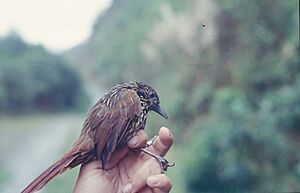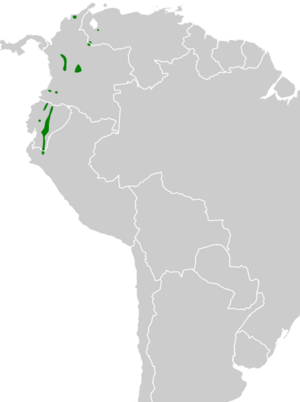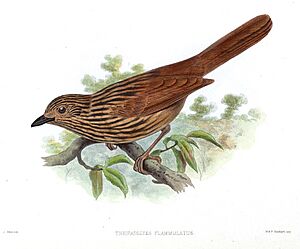Flammulated treehunter facts for kids
Quick facts for kids Flammulated treehunter |
|
|---|---|
 |
|
| Conservation status | |
| Scientific classification | |
| Genus: |
Thripadectes
|
| Species: |
flammulatus
|
 |
|
The flammulated treehunter (Thripadectes flammulatus) is a fascinating bird found in the forests of South America. It belongs to the ovenbird family (Furnariidae), which is known for building unique nests. You can spot this bird in countries like Colombia, Ecuador, Peru, and Venezuela.
Contents
Meet the Flammulated Treehunter
The flammulated treehunter is one of the largest birds in its group. It has a very striking pattern that makes it stand out. Both male and female birds look alike.
What Does It Look Like?
This bird is about 24 to 25 centimeters (9.4 to 9.8 inches) long. It weighs between 50 and 62 grams (1.8 to 2.2 ounces).
Its face and the top of its head are blackish. They have bright, golden-buff streaks, almost like flames. The back of the bird is browner, with blackish lines along the feathers. This color blends into a rich brown on its lower back.
The wings have a reddish-brown color with thin streaks. Its tail is a dull chestnut-brown. The throat, chest, and upper belly are streaked with blackish and golden buff. These colors fade to a rich brown on its lower belly.
The bird's eyes are brown. Its beak is black, and its legs and feet are dark gray-brown. Young flammulated treehunters have less clear streaks than the adults.
Where Does It Live?
The flammulated treehunter lives in different parts of the Andes mountains. You can find it in the Andes of southwestern Venezuela and throughout Colombia. It also lives in the Andes of Ecuador and northern Peru.
This bird prefers montane evergreen forests and temperate forests. It especially likes thick areas of Chusquea bamboo. It usually lives at high elevations, mostly between 2,200 and 3,500 meters (7,200 and 11,500 feet) above sea level. Sometimes, it can be found as low as 700 meters (2,300 feet) in western Colombia.
How It Behaves
The flammulated treehunter stays in the same area all year round. It does not migrate.
What Does It Eat?
This bird mainly eats arthropods, which are creatures like insects and spiders. Scientists think it might also eat small animals with backbones. It usually looks for food alone. Sometimes, it joins groups of different bird species feeding together. It mostly searches for food in thick bushes. It picks up prey from branches, moss, and other plant material.
How Does It Raise Its Young?
The breeding season for the flammulated treehunter is not fully known. However, it includes at least the months of June to October.
The bird digs a tunnel in an earthen bank. At the end of the tunnel, it builds a nest. The nest is made from rootlets, bamboo fibers, and other plant parts. So far, only two nests have been found, each with two eggs. We don't know how long the eggs take to hatch or when the young birds leave the nest. Both parents help feed the baby birds.
What Does Its Song Sound Like?
The song of the flammulated treehunter is a series of harsh, grating notes. It starts slowly, then gets faster and louder. Its call, used to communicate, is a sharp and strong "check!" sound.
Conservation Status
The IUCN (International Union for Conservation of Nature) has listed the flammulated treehunter as a species of "Least Concern." This means it is not currently at risk of disappearing. It has a large area where it lives. The total number of these birds is unknown, but it is believed to be stable. There are no immediate threats to this bird. It is generally considered uncommon. It can be found in two protected areas in Ecuador.




